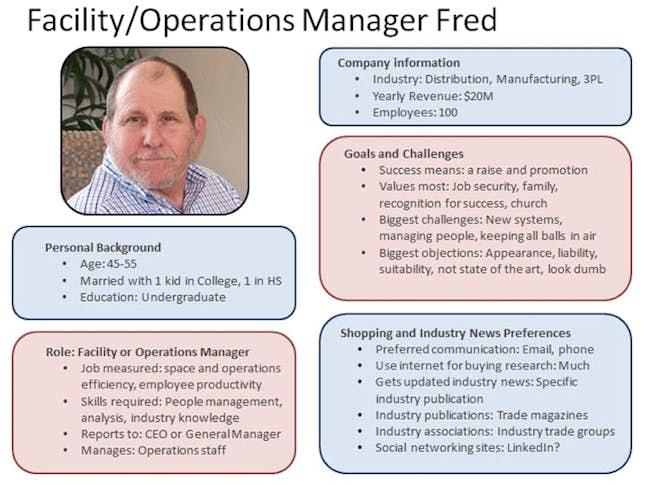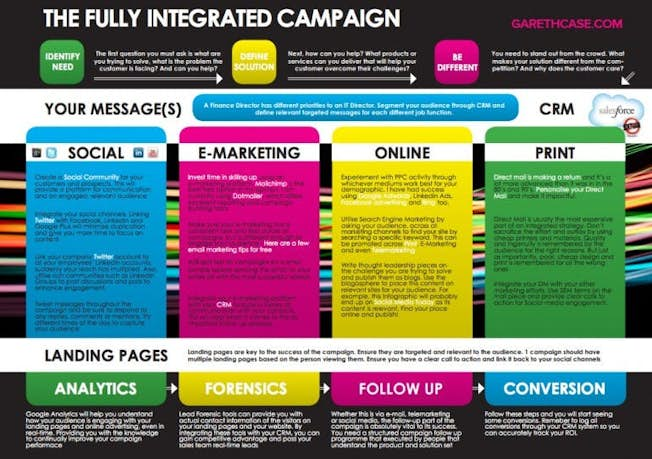An effective marketing campaign demands research, planning, time, and patience. There’s a lot of noise to compete with to ensure your message gets to the right people at the right time, so it’s wise to make sure you take the time to plan each step.
If you’ve never run a marketing campaign before, it can be tough to understand all the working parts. There are also a lot of channels to consider and you’ll need to combine the power of traditional and digital media through an integrated marketing campaign to ensure success.
This article will show you the elements and stages required to create and implement your first marketing campaign. Let’s get started!
Outline Your Individual/Company Marketing Goals
Before you can plan any campaign, you need to understand and outline your overall marketing goals. Establish SMART (Specific, Measurable, Attainable, Realistic and Timely) objectives for best results.
Your goal might be to gain ten new clients a month, sell twenty products a week, or increase your income or revenue by 30%. Your goals can be centered around sales, customer satisfaction or profits, but the key is to establish them from the get-go so you can track and measure campaign performance.
Determine Your Budget
Before you start to research, you’ll want to determine your budget. Why? Because persona research often costs money, and you’ll want to include these costs as part of your campaign budget. Determining how much money you can spend early in the campaign planning process will help determine your goals, strategy and even how much content you can create. Check out this handy digital marketing budget toolkit to get you on the right track.

Perform Market Research
Market research is essential to understand your audience. You may think that who you want to market to and engage is from one group, but then you find out after research that it’s another cohort you never thought of. This is why creating buyer personas is important and market research feeds into their development.
So how do you start? Describe your product or service, its features and benefits in detail, as well as how it differs from your competitors. Then focus on your key product or service features, including pricing, service, distribution and placement. Finally, collect, organize and write down this information. Some areas to consider include:
- Market dynamics, patterns such as seasonality
- Product - what's currently available? What is your competition selling?
- Industry benchmarks
- Potential vendors and partners that you will need to rely on
In this step, you also need to consider your competition and develop your Unique Selling Proposition (USP). What makes you different from your competitors? Write a few sentences that clarify:
- Who your key market is
- What you sell or offer
- Your USP
These exercises will help you determine your target market and how to effectively sell your product or service. This research will all feed into the next step - persona marketing research.
Determine Your Target Personas
Though determining your target personas is often a part of the market research process, it’s important enough to deserve its own step.
To connect with and engage your target audience, you need to ask yourself questions. What are your customers’ motivations? How do they like to communicate? Where do they like to find information? What marketing channels do they use? If they use social media, what do they look for or talk about? Knowing the answers to these questions will help you develop a successful marketing strategy.
How do you Build Marketing Personas?
- First, describe your ideal target customer in terms of age, gender, family composition, earnings, likes and dislikes, lifestyle, purchasing patterns, buying objections, hobbies, etc.
If you need help getting started, just download this buyer persona template.
- Test your target customer assumptions. You may not always sell to who you think, or may not reach your full potential with this target audience. Do this through in-person or online focus groups (if you have a budget), customer surveys, quiz targeted at your followers on social media, or use audience listening tools or paid external surveys to get your information. If you find out who responds to your product/service most enthusiastically then that’s your real target market!
If you need help getting started, just download this buyer persona template.
The information you need to learn about your personas includes:
- Name of the persona e.g. stay at home mum or career climber
- Job title
- Company size and industry
- Title/ details of role
- Gender
- Salary
- Education
- Location
- Age
- Education
- Pain points - these are specific problems that your current or prospective customers face e.g. they want to save money or time and are looking for a product or service to help them do that.
- Goals
- What types of content/promotion they like/dislike
- Fears/motivations
- Common objections during the sales processes
Blank Persona Template Example

Outline Your Campaign Goals
Once you’ve determined how to sell your product and who to sell it to, you can start to outline your specific campaign goals and tie them to a strategic digital marketing plan. Here you will define ‘The Big Idea’ for your campaign. This idea will determine how you connect with and convince your audience.
You will also decide whether your focus is on creating brand awareness, customer acquisition or retention and growth. Again, you should create SMARTER objectives You should then choose and track Key Performance Indicators (KPIs) based on these goals.
Because you already have a budget in mind for your campaign, you can tie many of your goals to a monetary value. For example, perhaps you want to spend $1,500 on Facebook ads and get X amount of views and X amount of new customers. By the time you get to the analytics portion of your campaign (more on this later), you can easily determine your marketing ROI and see if you’ve achieved your goals.
Finally, during this step, you’ll want to decide what content types to use in your campaign. You may choose some of the tactics below to achieve your goals, but whatever you do, be sure to consider your personas’ preferences. Do they like to read? Watch videos? Respond well to ads? For the best results, create content that can be leveraged in many formats (a blog that can be broken into an infographic or images converted into memes).
A Successful Marketing Campaign May Include the Following Elements:
- The power of email marketing
- Social Media
- SEO
- PPC
- Automation
- Demand generation
- Convertible landing pages/website/e-commerce pages that convert
- Content marketing (created, curated, etc.)
- Events
- Press Releases/PR
- Analytics
- ‘Direct’ marketing (traditional media)-- magazines, print ads, fliers, etc.
- Customer Relationship Management (CRM) platforms e.g. HubSpot
- Coupons
- Demos/evaluations/trials
Successful campaigns often include many different content formats. Once you’ve determined what content types to use, you can choose how to measure success. For example, saying you want to ‘increase sales’ isn’t enough. Do you want more people to buy dresses from your ecommerce site? Check out six ecommerce strategies to future proof your business.
Before you move on to the next step, make sure you create a marketing campaign brief to map out each element of your campaign.
Content Creation
So you’ve done your research, and you are ready to start creating content. But you don’t have to do everything. Many companies outsource to freelance writers or agencies to create their content (blogs, ebooks, videos, infographics etc.) so they have more time to focus on strategy. You may choose to do some or all of the content creation yourself and outsource any design or video elements.
Whatever you decide, make sure to keep your personas front of mind throughout the creation process. There are also some free content creation tools and resources you can use to keep your budget in check. This chart from Workplaces shows what a truly integrated marketing campaign looks like.

Marketing Campaign Promotion & Execution
Once you’ve finalized your content and got sign-off from any stakeholders, it’s time for promotion and execution.
There are many inbound marketing tactics you can use, including those listed above, such as social media, email, pay-per-click ads, public relations, telemarketing and more. Anyone who enters your sales funnel via any channel (event, telemarketing calls, landing page) can prove to be valuable, even the ones who don’t purchase right away.
However, not every channel will be right for your business. Ask yourself the strengths and weaknesses of each channel. Do they perform, and if not, why not? How will they help you reach business and revenue objectives?'
Analyze your Marketing Campaign
Marketing campaigns must have analysis built-in based on focused metrics. That way, you can ensure your budget goes towards the right tactics and channels using the most effective content and messaging.
Here are some effective ways to measure and analyze campaign performance:
- The number of organic website visits to your content (use Google Analytics)
- Time spent on page (use Google Analytics)
- Email open rates and click-through rates (marketing automation software, such as Marketo)
- Click-throughs and referrals from paid ads (Google Analytics)
- Number of prospects earned at an event (various ways)
- Engagement (likes, shares) on social media (paid social analytics tools such as Simply Measured, or free analytics from the social networks themselves.)
Use a Google Analytics goals guide to find out how to measure KPIs and track campaigns effectively.
Whatever way you decide to track your campaign, make sure you have enough information to make the case to your team, boss or yourself to continue investing in marketing.
Invest in your marketing knowledge
Above all, the best thing you can do when embarking on your first campaign is to invest in your marketing skills. With DMI’s Professional Diploma in Digital Marketing, you will understand the fundamentals of digital marketing and learn how to use the channels available to optimize your marketing activity such as social media, paid search, SEO, email, analytics, and much more.
First published August 2017, Updated November 2021
- Categories:
- Articles
- Digital Strategy
Upgrade to Power Membership to continue
your access to thousands of articles, toolkits, podcasts, lessons and much much more.
Become a Power Member- Login
- View Courses
- - - -
- Courses
- Resources
- - - -
- My Account
- Change Password
- Logout




